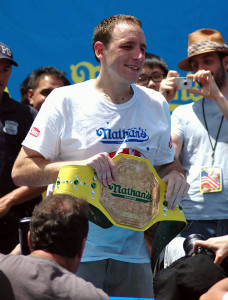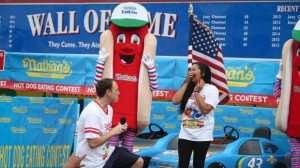I WATCHED NATHAN’S Hot-Dog-Eating Contest for the first time this year and I feel obliged to say it was an accident. It came on ESPN2 after the Germany-France World Cup quarterfinal –just as I was planning to doze away for an Independence Day nap. But I found myself intrigued by this ridiculous spectacle of gluttony, albeit with a touch of shame, as if I’d just caught myself rubbernecking at a horrifying highway pileup. Joey “Jaws” Chestnut inhaled 61 hot dogs in 10 minutes that day, enough to win, but short of his previous year record of 69.
Chestnut has it down to a science. He dunks the buns in water to shrink them and make them easier to swallow. He jams the dogs down his throat as his head bobs like a pelican gulping down a fish. It all happens with a speed that is undoubtedly repulsive, but also just astounding. Each hot dog goes down the hatch in an average of less than 10 seconds.
As I watched, I found myself baffled by the basic anatomy: how the hell does he fit all those frankfurters inside his body? After all, as a second-year resident in pathology, I’ve seen plenty of stomachs. They’re not all that big.
We examine stomachs during an autopsy and also after a gastrectomy, the surgical removal of a stomach. It is, shall we say, a hands-on experience (well, okay, we do wear gloves). Stomachs are roughly the shape of the letter “J” and lined with muscle that causes peristalsis, an involuntary contraction that churns up food and squeezes it along the GI tract. When the average stomach is empty and relaxed, its volume is about 45 to 75 milliliters – which can be contained in a shot glass or two. But it has a natural elasticity, so it can expand to hold about one liter of food—roughly a few cans of Coke.
Believe me, I am a card-carrying member of the Clean Plate Club. And I love a good hot dog, especially the kind we have here in Chicago, where they’re served with mustard, tomatoes, a dill pickle, chopped onions, peppers, celery salt and a relish that’s so bright green it looks radioactive. And never ketchup. God forbid you desecrate that dog with ketchup.
But my stomach cries “No mas” after I’ve had two or maybe three. So, 69? How is that even possible?

Joey “Jaws” Chestnut after taking the crown (and belt) in 2009.
~
America’s fascination with eating a shitload of food (sorry, couldn’t resist) is nothing new, from the legendary 72-ounce steak at the Big Texan Steak Ranch in Amarillo to the all-you-can-eat buffets in Vegas to whatever absurdly oversized ice cream sundae they dare you to eat at your local parlor. In 2008, the Travel Channel introduced Man v. Food, in which host Adam Richman partook in food challenges all across the country such as a five-pound Philadelphia cheesesteak, a seven-pound breakfast burrito in Denver and a twelve-pound burger in Boston.
We live in a land of plenty. Outlandish feats of overconsumption are as American as apple pie. Or, better yet, an apple pie eating contest, like the one last year in Brunswick, Ohio, which Chestnut won by devouring almost four and a half pies. It was an ad absurdum version of the wholesome, time-honored county fair pie-eating contests held all across the country in the summer time—a classic photo-op for parents and, I suppose, sloppy fun for kids dipping their beaks into the pie crusts (assuming it all does not end up like that scene in “Stand By Me”).
Legend has it that the first Nathan’s hot dog eating contest took place in 1916 among four immigrants trying to prove who was the most patriotic. The contest became a 4th of July tradition in the 1970s when the winners typically downed about ten to nineteen wieners.
In 2001, Takeru Kobayashi, who is Japanese and nicknamed “The Tsunami,” drastically escalated stakes on Coney Island—and provided a publicity boom for competitive eating as a whole – when he sucked down 50 hot dogs and crushed the record set the year before of 25½. Chestnut surpassed Kobayashi in 2007 and has won the event every year since.
An organizing body, Major League Eating, now exists to promote and regulate the safety of eating contests – which involve an enormous array of foodstuffs from asparagus to Twinkies. Competitors undergo extensive conditioning and practice, so some argue that it is a kind of sport.
Critics have called the events gluttonous and immoral for celebrating overconsumption in a world where many go hungry, but media coverage is wide and ESPN annually broadcasts the Coney Island contest, the premier event on the international competitive eating circuit.
“Nathan’s is by far and away our biggest and our best and the greatest contest that we do,” Major League Eating CEO George Shea told Forbes this year.
Winners at Nathan’s take home a coveted mustard-colored belt and $10,000 in prize money. Although most competitors do not earn enough money to make a living at it, Shea said Chestnut competes in about 25 eating contests a year and earns more than $200,000 annually in prizes, appearance fees and other sponsorship income.

How many french fries with gravy and cheese curds can you eat? Joey “Jaws” Chestnut can down a lot as he did to win in 2012.
“Everything in moderation,” our parents may have told us when we were kids, but we live in an era of extremes. Extreme sports. Extreme games. Extreme makeovers. Running 26.2 miles isn’t enough for some people anymore so there are ultra-marathons 50 or even 100 miles long.
When Chestnut, 30, ate 69 hot dogs last year, he was taking in more than 20,000 calories. In 10 minutes. The Institute of Medicine’s Dietary Reference Intakes, designed to serve as a guide for good nutrition, recommends that a moderately active man in his thirties consume about 2,400 to 2,600 calories per day.
As I watched this year’s contest, I had the same reaction as most other sane people: this cannot be good for your health. And that was before hearing about the 47-year-old man who choked to death eating hot dogs in a 4th of July contest in Custer, S.D.
~
Turns out, there actually has been study on this. Conducted by doctors at the University of Pennsylvania School of Medicine for a National Geographic special, it was published in 2007 in the American Journal of Roentgenology. “Roentgenology” is the use of radiation, such as X-ray, in the diagnosis and treatment of disease.
The researchers used fluoroscopy – a kind of moving X-ray image – to compare the stomachs of a 29-year-old male competitive eater ranked in the top-ten speed eaters in the world with a 35-year-old male who was just a normal guy with a healthy appetite.
That participant, the “control” in the experiment, was chosen in part because he was larger – on the outside – at 6’2”, 210 lbs. The speed-eater was, the researchers noted, “surprisingly slim and fit” at 5’10” and 165 lbs.
Size of stomach does not necessarily correlate with size of person. Kobayashi is just 5’8”, 128 lbs. Former Chicago Bear William “The Refrigerator” Perry, who was listed at 6’2” 335 lbs in his playing days, appeared at the Nathan’s contest in 2003 as a celebrity contestant and stopped after eating just four dogs. Chestnut is 6’1” and about 220 lbs.
Before the study, the UPenn doctors, who specialized in gastroenterology and radiology, speculated that speed-eaters were able to stuff their guts with so much food because of one of two mechanisms: either their stomachs emptied quicker than most and swiftly sent a bolus into the intestines, or their stomachs had expanded capacity due to their training.
The participants were given barium which highlighted the shape of the stomach on imaging and handed a dog pile of wieners.
When the control subject had eaten seven hot dogs, he announced that he would be “sick” if he ate another bite. We’ve all been there. When he lifted his shirt, however, his abdomen appeared about the same as it had at the start.
The speed-eater downed 36 hot dogs over 10 minutes before the researchers cut him off. Fluoroscopy showed a stomach that resembled a “massively distended, food-filled sac occupying most of the upper abdomen with little or no gastric peristalsis.” When he lifted his shirt, it looked, they said, like he had a “developing intrauterine pregnancy.”
Furthermore, a couple hours after filling up, the competitive eater’s stomach had only moved about a quarter of the radioactive meal along to his small intestine, while the control subject’s stomach had emptied three-fourths of his food intake, which is in the normal range (greater than 50%).
It brings to mind the python that swallows an antelope whole and digests it for weeks.
To be able to do this, competitive eaters gorge themselves for years until their stomach can tolerate larger and larger amounts of food. Over time, the stomach’s capacity expands and the eater overcomes the body’s natural checks and balances that give us the sensation of fullness and satiety at the end of a meal – a message sent to our brains by the vagus nerve, which regulates the digestive system.
Chestnut’s routine before a contest includes fasting for three days while drinking tons of water to stretch out his stomach muscles. “You can fool your body into accepting more,” he told Esquire in a 2010 interview. “I’m jumping up and down to control my stomach and push the food through faster. It wants to settle in your stomach, but I’m getting the food to settle farther and farther down.”
The speed eater in the study reported that he avoided becoming overweight even though he never felt full by eating measured food portions and never refilling his plate – that is, when he wasn’t competing or training. But the researchers expressed concern that it would be difficult to maintain this discipline over the course of a lifetime—and a never-sated stomach may lead to morbid obesity.
And how will that stretched-out stomach fare over time? The UPenn physicians suggested it may decompensate and develop gastroparesis—a condition where it becomes incapable of emptying food, which may result in intractable nausea, indigestion and vomiting. To relieve those symptoms, a partial or total gastrectomy might even become necessary, they said.
“We recognize that we may be extrapolating unfairly based on a sample size of one,” the researchers wrote in their 2007 report. “Nevertheless, the fluoroscopic findings in our speed-eater were so dramatic that we suspect our observations in this case can be applied to competitive speed eaters in general.”
Competitive eating may be popular, they concluded, but it “is a potentially self-destructive form of behavior.”
~
Unlike the stomachs seen with X-ray imaging in the study, the ones we encounter in pathology already have been removed from the body. Gastrectomies are performed for stomach cancer, but more often we see what is known as “sleeve gastrectomies,” in which part of the stomach is removed in a morbidly obese patient who has not been successful losing weight with attempts at diet and exercise.
In this surgery, the stomach size is reduced to a thin tube about the size of a banana so it will fill up quickly, reduce hunger and thus the patient will drop weight. It’s the opposite of what competitive eaters do to their own stomachs.
We have an epidemic of obesity in this country, another form of body extreme, and with it comes an increased risk of diseases such as diabetes mellitus type II, heart disease and non-alcoholic fatty liver disease, which can progress to cirrhosis, without, as the name implies, the patient ever touching a drop of alcohol.
Maybe the human body was not made to endure certain extremes.
Chestnut seems like a nice guy. He’s certainly found something he’s good at. Before this year’s Coney Island contest, he dropped down to one knee and proposed to his girlfriend, who also competes in eating contests. She accepted.
I wish them and their stomachs a long and happy life together.

Joey Chestnut drops to his knees before Neslie Ricasa this July


